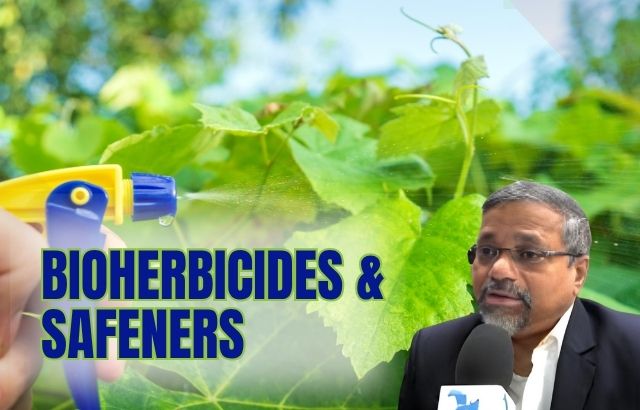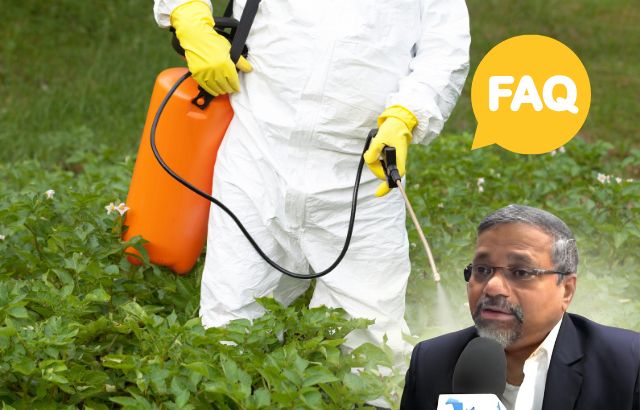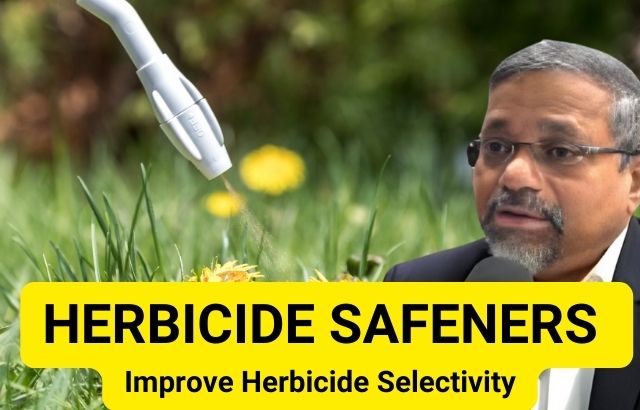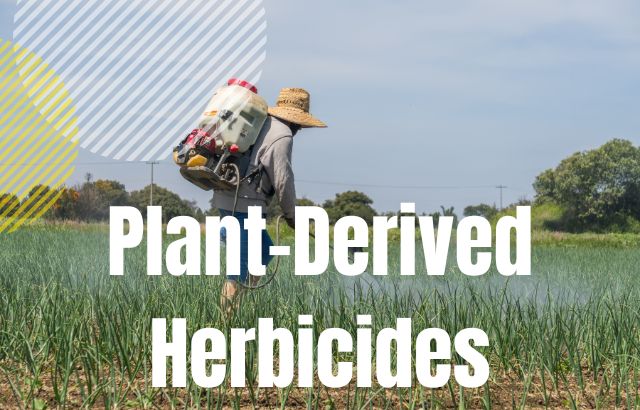In modern agriculture, managing weeds effectively while protecting crops from herbicide-induced damage is an ongoing challenge. Herbicide safeners have emerged as vital tools to address this issue. These innovative chemicals enhance the selectivity of herbicide applications, ensuring effective weed control without compromising crop health. As agricultural practices evolve, herbicide safeners play an increasingly important role in improving the sustainability of farming operations.
Jaiguru Kadam, a subject matter specialist with vast international experience, emphasizes that herbicide safeners are essential for optimizing herbicide use and promoting long-term sustainability in crop production. With his extensive background in agrochemicals, Kadam has been at the forefront of researching and developing these technologies, particularly focusing on their environmental impact and efficacy.
In this article, we’ll explore the role of herbicide safeners, their benefits, practical applications, and industry insights, drawing on real-world examples and expert perspectives, including those of Jaiguru Kadam.
What Are Herbicide Safeners?
Herbicide safeners are chemicals designed to protect crops from the harmful effects of herbicides while still allowing those herbicides to target weeds. Safeners work by activating specific biochemical pathways within plants, helping them to detoxify or break down herbicides more efficiently. This selective protection ensures that the herbicide controls weeds without causing damage to the desired crop.
The main function of a herbicide safener is to mitigate the crop injury that can occur when a non-selective herbicide is used. They are typically used when applying herbicides that might harm crops, especially for sensitive species like rice, corn, and soybean.
How Herbicide Safeners Work
Herbicides generally disrupt essential processes in plants, such as photosynthesis, cell division, or protein synthesis. Safeners help crops reduce the negative effects of herbicides by either:
- Activating detoxifying enzymes: Safeners can trigger enzymes that degrade or modify the herbicide, rendering it less toxic to the plant.
- Altering herbicide target sites: Some safeners may alter the molecular structure of the herbicide’s target site in the crop, reducing its effect on the plant.
For example, in rice farming, safeners like naphthalic anhydride help protect rice plants from the damaging effects of certain herbicides like pre-emergence grass control agents, allowing them to thrive while still effectively controlling weeds.
Benefits of Herbicide Safeners
- Improved Crop Protection: Safeners help protect crops from herbicide injury while maintaining their effectiveness in controlling weeds. This makes herbicides safer to use on sensitive crops.
- Enhanced Herbicide Efficiency: Safeners improve the overall effectiveness of herbicides. By reducing crop injury, they ensure that herbicides can target weeds without harming the crop, resulting in a more successful weed control strategy.
- Higher Yields and Better Quality: With reduced damage from herbicides, crops can grow more vigorously, leading to higher yields and better crop quality.
- Sustainable Weed Management: Safeners allow the selective use of herbicides, reducing the chances of overuse and helping to prevent herbicide resistance. This leads to more sustainable weed management practices.
- Reduced Herbicide Resistance: Herbicide safeners enable farmers to rotate herbicides effectively, which helps reduce the selective pressure on weed populations, potentially delaying the development of herbicide resistance.
Real-World Examples of Herbicide Safeners in Action

- Rice Farming with Naphthalic Anhydride (NA):
- Rice is highly sensitive to herbicides, particularly those used for controlling grass species. By using safeners like naphthalic anhydride (NA), rice farmers can safely apply pre-emergence herbicides like fenoxaprop without damaging the crop. The safener helps the rice plants metabolize the herbicide more efficiently, allowing for better weed control.
- Corn and Grass Weed Control:
- Fenoxaprop-p-ethyl is a widely used herbicide for controlling grass weeds in corn. However, corn can be sensitive to this herbicide. By incorporating safeners, such as benoxacor, farmers can apply fenoxaprop-p-ethyl with minimal risk of crop damage, ensuring effective weed control while protecting the corn.
- Soybean Farming with Haloxyfop:
- Soybean plants are sensitive to herbicides like haloxyfop, which are used to control grass weeds. The application of safeners, such as benoxacor, allows the safe use of haloxyfop without harming soybean crops, ensuring a healthy and productive harvest while maintaining effective weed management.
The Role of Green Innovators and Industry Experts
Jaiguru Kadam, a seasoned expert with a wealth of international experience, highlights the importance of herbicide safeners in fostering sustainable agriculture. According to Kadam, “Herbicide safeners are not just about preventing crop damage; they are integral to improving the overall efficiency and sustainability of herbicide applications. When used appropriately, safeners help ensure that we are using chemicals more responsibly, reducing waste and promoting ecological balance.”
Kadam’s research focuses on the development of novel safeners that can be used in diverse agricultural contexts and help minimize environmental risks. By working with international agrochemical companies, Kadam has contributed to the development of safer, more effective herbicide formulations that are tailored to various crops, climates, and growing conditions.
Calculations: Herbicide Efficiency and Safener Impact
To illustrate the practical benefits of herbicide safeners, consider the following scenario:
- Scenario: A corn field is treated with an herbicide at an application rate of 100 g/ha. Without safeners, the herbicide causes a 20% crop injury. After applying a safener, the crop injury is reduced to 5%.
Without Safeners:
- Crop injury = 20% of 100 g/ha = 20 g/ha
With Safeners:
- Crop injury = 5% of 100 g/ha = 5 g/ha
Total Reduction in Crop Injury:
- Reduction = 20 g/ha – 5 g/ha = 15 g/ha
- This is a 75% reduction in crop injury, demonstrating the safener’s effectiveness in protecting the crop from herbicide-induced stress.
Herbicide Safeners and Integrated Pest Management (IPM)
Herbicide safeners are a critical component of Integrated Pest Management (IPM). IPM involves using a combination of biological, cultural, mechanical, and chemical methods to manage pests in an environmentally and economically sustainable manner. Safeners help by:
- Reducing chemical dependence: With safeners, farmers can use herbicides more selectively, targeting weeds without over-applying chemicals that could harm crops or the environment.
- Supporting biodiversity: By enabling the use of more selective herbicides, safeners contribute to preserving beneficial organisms, such as pollinators and natural predators of pests, which are essential for ecological balance.
FAQs About Herbicide Safeners

1. What are the different types of herbicide safeners?
- Mechanistic safeners: These activate detoxifying enzymes in plants.
- Metabolic safeners: These alter the metabolism of the herbicide in the plant to reduce its toxic effects.
2. Can herbicide safeners be used in all crops?
- No, herbicide safeners are crop-specific. It’s essential to use safeners tailored for the specific crops and herbicides being applied.
3. Are herbicide safeners safe for the environment?
- Generally, herbicide safeners are designed to be safe for the environment. However, their safety is assessed through rigorous testing by regulatory agencies like the EPA and EFSA.
4. How do safeners help in herbicide resistance management?
- Safeners help reduce the overuse of herbicides by enabling more precise applications. This reduces the selection pressure on weed populations, potentially slowing down the development of herbicide resistance.
5. Do safeners affect weed control efficacy?
- No, safeners do not reduce the effectiveness of herbicides in controlling weeds. In fact, they help optimize herbicide use by protecting crops, which ultimately enhances overall weed management.
The Future of Herbicide Safeners: Trends and Innovations

Looking ahead, the future of herbicide safeners seems promising. Several trends are shaping the development of this technology:
- Biotechnology: Advances in genetic engineering may lead to crops that are naturally more resistant to herbicides, reducing the need for safeners altogether.
- Precision agriculture: Safeners will likely be integrated with advanced technologies like drones and variable-rate applicators, allowing for more targeted and efficient herbicide applications.
- Eco-friendly formulations: The demand for more environmentally friendly safeners will drive innovations in safer, biodegradable products that leave minimal environmental footprints.
Conclusion
Herbicide safeners have become indispensable in modern agricultural practices. By allowing farmers to use herbicides more selectively, they help protect crops from herbicide injury while maintaining effective weed control. With contributions from experts like Jaiguru Kadam, the development of herbicide safeners continues to evolve, offering more sustainable solutions for agriculture.
These innovations not only improve the efficiency of herbicide use but also help address global challenges like food security, environmental sustainability, and herbicide resistance. With ongoing research and technological advancements, herbicide safeners will continue to play a crucial role in shaping the future of agriculture











